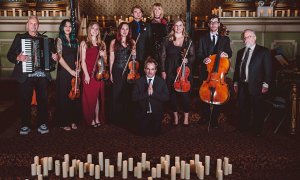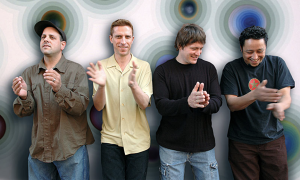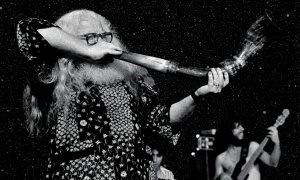Home » Jazz Articles » From the Inside Out » From Microtones to Mauro to MFSB
From Microtones to Mauro to MFSB
 Dave Fiuczynski
Dave FiuczynskiFlam! Blam! Pan-Asian Microjam!
RareNoise Records
2016
Simultaneously dedicated to 20th century classical composer Olivier Messiaen and legendary rap and hip-hop producer J Dilla, Flam! Blam! Pan-Asian Microjam! is a musical adventurer's dream and a purist's nightmare. But anything more conventional from conceptualist, composer and guitarist David Fiuczynski would probably be disappointing—after all, he's the "Fuze" who lit the raging bonfire of the Screaming Headless Torsos, whose rock experimentation was once famously described as a "jazz/rock/funk orgy."
Flam! Blam! draws from Fiuczynski's service as Director of the Planet MicroJam Institute, devoted to studying microtonal harmonies that expand the traditional twelve-tone Western chromatic scale (intervals smaller than a semitone or "the notes between the notes") at the Berklee College of Music. His band comprises former Institute students Utar Artun and Jack Sherman, (microtonal keyboards), Justin Schornstein (bass), Alex "Bisqit" Bailey (drums), Helen Sherrah-Davies (violin) and Yazhi Guo (Chinese oboe and percussion), with fellow free spirit Rudresh Mahanthappa contributing alto saxophone to the last three tunes.
But Flam! Blam! is even more far out than that: It connects the dots between Messiaen's music, Dilla's famous beats, Gagaku (ancient court music from Japan), and field recordings of five bird calls (the Common Loon, the Carolina Chickadee, the Northern Nightingale, the Blackface Solitaire and the Brazilian Uirapuru) transcribed for fretless guitar, violin, and microtonal keyboard. "When it comes to groove music, in terms of microtonality, you can really be a musical Captain Kirk and go where no man has gone before," Fiuczynski understates. "The field is wide open."
The opening "Loon-Y Tunes" employs the calls of the Common Loon and Carolina Chickadee, and haltingly stops and starts, pecking at the melody like hungry birds digging the ground for breakfast. Fiuczynski's guitar wobbles in, bending notes with a liquid, coming up from underwater, sound, while wood blocks and other percussion count the beat down like a slowly unwinding clock. "Dance of the UiraPuru" honors the sonorous Brazilian songbird with violin that soars and dives as if reveling in the freedom of flight.
Flam! Blam! moves even further out from there. In less than three minutes, "Oiseaux JDillique" welds J Dilla's "flam" beats into the call of the Northern Nightingale, Fuze's solo sounds like a catfight in the middle of a bird's nest, and the bassist ignites a frantic, thundering rhythm like free jazz dynamite. Fiuczynski doubles on piano to combine trademark Messiaen chords with his guitar-emulated Gagaku orchestra in "Gagaku Chord Candy." Full of empty space, violin moves resolutely back and forth within like a spider patiently weaving its web while Guo's otherworldly oboe moans and throbs—the overall effect is the sound of Yusef Lateef's groundbreaking Eastern Sounds played by aliens in floating spacecraft weirdness.
If you organize your music collection by style or genre, good luck with finding a place for Flam! Blam! Pan-Asian Microjam!
 Fresh Cut Orchestra
Fresh Cut OrchestraMind Behind Closed Eyes
Ropeadope Records
2016
It's difficult to believe that the rich, full Mind Behind Closed Eyes is only the second release from Philadelphia's Fresh Cut Orchestra; it sounds so much more developed and mature than that. Composed by the Orchestra's core trio of drummer Anwar Marshall, bassist Jason Fraticelli and trumpeter Josh Lawrence, and rounded out by a host of guest keyboard, guitar, reed, brass and percussion players, Mind Behind Closed Eyes was recorded all the way live (including the electronics) and surveys vast geographic and imaginary landscapes. "We wanted people to be surprised by every track, to not know what would come next," Lawrence allows.
Two romantic destinations, Puerto Rico and Italy, inspire this set's bookends. Fraticelli reflects on "My Summer In Puerto Rico" with his first recorded performance on the cuatro (the sunny island's most famous stringed instrumental export), an exquisite miniature bolero that shines just as sunny and bright. "Gallo Y Gallina," an instrumental Italian gallop depicting a race between a "Rooster and Chicken" brings down the curtain on the other end. In between, "Frederico," Lawrence's imagined combination of traditional Cuban danzón rendered in Chopin's harmonies, dances like a whirling dervish upon the joyous sheet of harmony, melody and rhythm woven by pianist Brian Marsella and percussionist Francois Zayas.
"New Expectations" seems to honor Pat Methenywith Marshall's pinwheeling yet flowing rhythms as the single tie that binds the horn chart and shimmering, strummed guitar chords together, then exploding through its climax with thundering echoes of Elvin Jones. "I believe Philly musicians have a certain conception of rhythm that we all agree upon, a rhythmic dialogue that we all understand," Marshall explains. "That language is very hard swinging, but its timing is laid back and relaxed."
"Mind Behind Closed Eyes" and "Augmented Reality" present different sides of the same introspective coin. The title track seems to open at its climax and remain there, especially the Fraticelli/Marshall rhythm section, which pummels the beat in flurries too fast for words. Lawrence spreads his spacewalk through his trumpet's upper register across two solos, shredding incisive and explosive modern jazz with the fearlessness of Eddie Henderson's early 1970s electric jazz-rock for Blue Note. With recurring breathing sounds, like you're walking around and listening inside someone else's head, "Augmented Reality" dives even deeper. Martial drums and baritone sax fall in step behind Fraticelli's measured walking bass into a tense, moody brooding that ultimately releases into a New Orleans trombone parade (complete with funky second line drumming)!
Mind Behind Closed Eyes was funded by the Pew Center's Philadelphia Music Project and supported in part through a grant from the Philadelphia Chapter of the American Composers Forum.
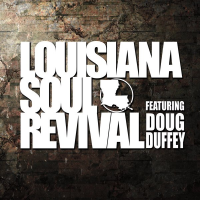 Louisiana Soul Revival
Louisiana Soul RevivalLouisiana Soul Revival Featuring Doug Duffey
Self-Produced
2016
Louisiana Soul Revival (LSR) frontman and primary composer Doug Duffey—already enshrined in the Louisiana Hall of Fame (in 2001) and the National Blues Hall of Fame (2009)—sure knows his musical roots. "North Louisiana, in the Mississippi Delta, has deep musical roots in the blues, Memphis soul, southern gospel, rock 'n' roll, folk, and hybrids that are uniquely its own," Duffey explains.
This eponymous debut gives voice to Duffey's extensive repertoire of funky, soulful originals primarily written between the 1970s and '90s. For example, its irresistible opener "Funky Bidneh" and "Be What R Ya" were written around the same time that Duffey was working through the iconic "One Nation, Under a Groove" with Parliament Funkadelic . (Other funkmeisters who have recorded Duffey tunes include George Clinton and Rare Earth.)
To steal and slightly twist the title of a famous Jay Geils Band tune: This set ain't nothing but a party, and sounds like a lost gem discovered midway between the Albert King blues and Bar-Kays funk-rock titles in the classic Stax-Volt label catalog. Guitarist (and arranger and producer) Dan Sumner opens "Funky Bidneh" with rhythm licks that feel like an instrumental puppy wriggling to get out of your hugging grasp; alto saxophonist Mason Howard solos with the early rock raunch of New Orleans' famous Specialty Records and Sumner's solo shows off his major-league fastball—high, hard and nasty. Duffey's tightly wound three-minute nugget "1-900-For-Love" would have been a great tune for Little Milton or Z.Z. Hill to sing.
"It Ain't What Ya Do" keeps the rhythm rocking back and forth, a funky see-saw for your ears to jump on, while Duffey's vocal overflows with authentic southern soul: A little bit country, a little bit funky, a little bit rockin' but all the way soulful. "There's a real tangible difference that you can hear in Louisiana's music. It's more rhythmically intricate," Sumner suggests. "In Louisiana, music is uniquely rhythmic across all styles."
It's also uniquely rhythmic across genders: Betsy Lowe and Naomi Holder shimmy and stomp through the lead and backing vocals of "Do It Right" (which Duffey originally wrote for The Brides of Funkenstein). These female vocals may introduce a new sound, but the music behind them remains a rolling and tumbling caldron of steaming funk. "We have energy coming from lots of different places in life," Sumner concludes. "It's a big, blasting full sound. It's a big gumbo."
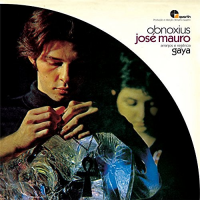 Jose Mauro
Jose MauroObnoxius
Far Out Recordings
2016
The oddly-titled Obnoxius bears precious little, and yet quite curious, baggage. Little is known about its original 1971 release other than it came out on a label founded by Brazilian producer Roberto Quartin, who also worked with Eumir Deodato.
We seem to know even less about songwriter, guitarist, vocalist and arranger Jose Mauro. We know he co-composed Obnoxius with Brazilian writer and journalist Ana Maria Bahiana, and, from its lushly layered sound, that Mauro greatly admired the orchestral arrangements of Lindolfo Gaya, one of Brazil's most accomplished composers, arrangers and orchestrators.
But there his trail stops: He seems to have disappeared before Obnoxius was finalized for release. Rumors of his disappearance include him being abducted by the Brazilian military to silence his voice, or being killed in a fatal car accident. Eventually, Quartin finished Mauro's project with subtle yet brilliant string arrangements and released Obnoxius.
45 years later, as the first title in Far Out Recordings' planned series of Brazilian label reissues, Obnoxius unveils deep and mysterious, dreamlike—almost subliminal—music. Like Antonio Carlos Jobim, Mauro does not sing with exceptional vocal technique but wins your ears over with the great feeling and nimble phrasing of his plaintive, genuinely warm voice. In the opening, title track, his spoken word vocal flutters like a bird trapped in its mainstream 1960s jazz brass arrangement. "Tarde Nupcias," a glorious combination of percussion, guitar, horns and strings, lasts little more than two minutes but renders emotion and ideas so much bigger than that. Built upon swirling strings, Bahiana's mid-song recitation and Mauro's acoustic guitar chords, strummed more hard and dark, "Memoria" suggests an acoustic prayer played as a whisper by the Velvet Underground.
Resoundingly ominous chords open and close Mauro's political protest "Apocalipse," which Wilson das Neves moves with slight yet powerful drum strokes, the pulsating sound of Dom Um Romao's legendary performance on the classic Francis Albert Sinatra / Antonio Carlos Jobim (1967, Reprise). The end of "Apocalipse" melts into the opening of "Exaltacao e Lamento de Ultimo Rei," a vocal ensemble piece that joyously, colorfully dances upon percussive Brazilian rhythms into this set's closing fade.
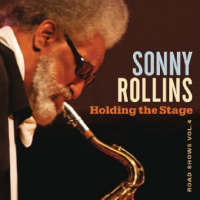 Sonny Rollins
Sonny RollinsHolding the Stage: Road Shows Vol. 4
Doxy Records
2016
At this point in his long and storied career, tenor saxman Sonny Rollins is probably incapable of releasing genuinely bad music (which isn't as obvious a statement as it may seem if, for example, you've tried to listen to Bob Dylan's Shadows in the Night Sinatra homage). Still, some sets are better than others, and Sonny recorded live onstage, spontaneously captured in the improvisational moment, is about as good as Sonny gets. "Something about the interaction of human being to human being creates a tension, and I get more involved, which probably changes what I'm doing," Rollins confides in Ted Panken's liner notes. "I'm not conscious of it. But once I'm out there, those forces obtain."
Road Shows Vol. 4 spreads out seven tracks recorded across more than three decades (from 1979 to 2012). It opens with one of his favorite concert staples, a stately yet emotive rendition of Duke Ellington's classic "In a Sentimental Mood" (2007, London). Recorded during Rollins' September 15, 2001, Boston performance documented on Without a Song: The 9/11 Concert (2005, Milestone), the closing, 23-minute heretofore unreleased closing "Medley: Sweet Leilani, Solo, Don't Stop the Carnival" is not only this set's pinnacle but ranks among the best live recordings of the saxophonist's entire career. Bassist Bob Cranshaw and drummer Perry Wilson move "Sweet Leilani" like an alluring belly dancer or, thanks to Wilson's rimshots, a bump 'n' grind striptease artist, with Rollins digging down into his tenor's "growling range" to match its down and dirty-ness. Just like that, the band shuts down and Rollins erupts into more than five minutes of spontaneous improvisation, doubling back on the familiar melodies of "Sweet Leilani," "St. Thomas" and even "Pop Goes the Weasel." And then just like that (again), the band roars back to pick up the colorful threads of Rollins' traditional calypso closer "Don't Stop the Carnival," which genuinely sounds, thanks to the rhythm section plus percussionist Kimati Dinizulu, like Rollins' saxophone is leading a conga line as it dances through the boisterous streets of Rio.
Like a truly great meal, there's nothing but scrumptious and sumptuous delights in between your appetizer and dessert, especially when Rollins turns to honor some of his favorite colleagues. "H.S." (2006, Toulouse) suggests Horace Silver's jaunty, sing-able melodies and their crafty rhythmic underpinnings, especially when Cranshaw upshifts his walking bass line into a more strident gallop. "Disco Monk" (1979, Finland) is another highlight: Rarely performed since it appeared on Don't Ask (1979, Milestone), Rollins bends and refracts Thelonious Monk's inscrutable classic "Nutty" throughout his improvisations, while electric bassist Jerome Harris and drummer Al Foster keep churning the smooth disco rhythm into compact nuggets of jazz and funk. "We only played that for a while. Some material I played depended upon the musicians who were working with me," Rollins recalls. "I don't think I ever played 'Disco Monk' with another group."
"This album consists of various periods of my career, with something for everybody," Rollins reflects. "It's who I am, and the music represents just about every aspect of what I do."
"I hear my shortcomings when I listen back to myself, but I tried to find some that I wouldn't want to shoot myself after hearing."
 The Young Philadelphians
The Young PhiladelphiansLive in Tokyo
Enja/Yellowbird Records
2016
Ah, The Sound of Philadelphia. For folks lucky enough to grow up in or around the City of Brotherly Love and Sisterly Affection in the mid-to late-1970s (I'm one), the very phrase resounds with memories, most emanating from Sigma Sound Studios on North 12th Street: Thick yet clear arrangements, pumping and thumping basslines and rhythms, masterful vocalists smooth (Billy Paul) and rough (Teddy Pendergrass), guided by the firm yet sensitive hands of soul entrepreneurs Kenny Gamble and Leon Huff and their gemstone, Philadelphia International Records.
Led by guitarists Marc Ribot and Mary Halvorson, The Young Philadelphians' Live in Tokyo presents a twin guitar avant-jazz retrospective on 1970s disco, funk, and soul. Even so, it's one of the most "rock 'n' roll" jazz sets you'll ever hear, played with punk rock abandon and supercharged by rampaging electric bassist Jamaaladeen Tacuma and drummer G. Calvin Weston (the group's only native Philadelphian), and sweetened just enough by three string players (Takako Siba, viola; Yoshie Kajiwara, violin; and China Azuma, cello).
It's evident from their opening rave-up of "Love Epidemic" (The Trammps) with the guitarists slam-banging chords like guitar jailhouse doors, and Tacuma rocking the bass line as if holding onto it for dear life. Ribot first solos spastically but then draws thick bold bright blue lines and smears them all over the rest of the music like James Blood Ulmer sketching the blues. They stomp out "Fly, Robin, Fly" (Silver Convention) with just as much howling energy: The rhythm section and strings play this more or less straight, while the guitarists smear electric colors all around, like a messy child's fingerpainting in sound. Ribot and Halvorson chop out the rhythm and hook to "Love Rollercoaster" (Ohio Players) to summon the rhythm section to thoroughly thrash its underlying bass and drum parts. Tacuma's bass solo shreds to bits what remains of the original composition, driving the tune from Dayton, Ohio (the Players' hometown) into far outer space, while the live strings maintain the melody.
Yet the ensemble also plays with subtlety and jazz style. Ribot slowly unravels the opening melody of "TSOP (The Sound of Philadelphia)" (Mother, Father, Sister, Brother—MFSB) like a lone gunman emerging from the horizon of a Ennio Morricone western, lifting the band to float in space and time as the violinists resolutely saw out the melody...and then Tacuma slips into the downbeat and the band kicks into a rocking four on the floor jam. Ribot also finds smoldering hard rock in his slow-burning instrumental take on "Love TKO," one of Pendergrass' most enduring "quiet storm" ballads.
Just like The Young Philadelphians scream out to end "TSOP": Let's get it on—it's time to get down!
< Previous
Picking Order
Next >
Take Five with Jared Pauley
Comments
Tags
From the Inside Out
Chris M. Slawecki
Olivier Messiaen
Screaming Headless Torsos
Utar Artun
Justin Schornstein
Alex Bailey
Helen Sherrah-Davies
Yazhi Guo
Rudresh Mahanthappa
Fresh Cut Orchestra
Philadelphia
Anwar Marshall
Jason Fraticelli
Josh Lawrence
Brian Marsella
Francois Zayas
pat metheny
Elvin Jones
Eddie Henderson
Louisiana Soul Revival Featuring Doug Duffey
Parliament-Funkadelic
George Clinton
J. Geils
albert king
Little Milton
Z.Z. Hill
Eumir Deodato
Antonio Carlos Jobim
Velvet Underground
Dom Um Romao
Sonny Rollins
Bob Dylan
duke ellington
Boston
Bob Cranshaw
Horace Silver
Thelonious Monk
Jerome Harris
Al Foster
Billy Paul
Teddy Pendergrass
Marc Ribot
Mary Halvorson
Jamaaladeen Tacuma
G. Calvin Weston
James "Blood" Ulmer
Ohio Players
Dayton, Ohio
For the Love of Jazz
 All About Jazz has been a pillar of jazz since 1995, championing it as an art form and, more importantly, supporting the musicians who create it. Our enduring commitment has made "AAJ" one of the most culturally important websites of its kind, read by hundreds of thousands of fans, musicians and industry figures every month.
All About Jazz has been a pillar of jazz since 1995, championing it as an art form and, more importantly, supporting the musicians who create it. Our enduring commitment has made "AAJ" one of the most culturally important websites of its kind, read by hundreds of thousands of fans, musicians and industry figures every month.






